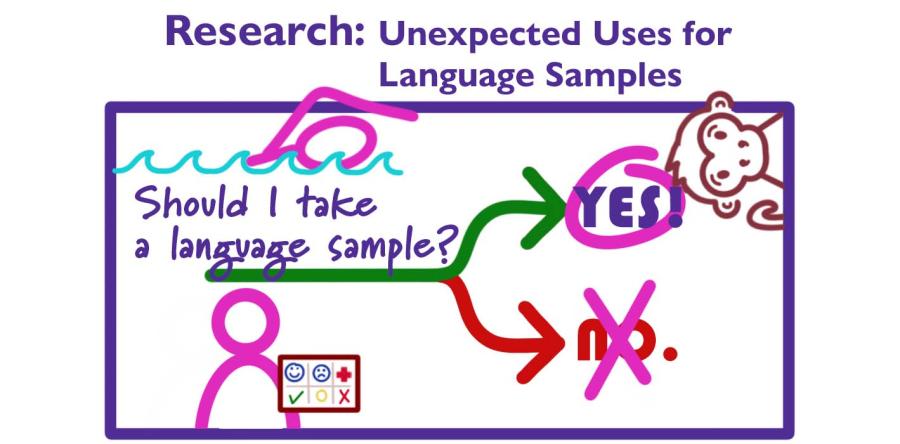
Research: Unexpected Uses for Language Samples

Research: Unexpected Uses for Language Samples
Published at: 2021-12-01
From toddlers with cochlear implants to adults with primary progressive aphasia (and everything in between), SALT has been part of researching people’s spoken language. Oh, and apes’ too! One of my great joys is consulting with researchers from Communication Sciences and Disorders, Psychology, Linguistics, Neuroscience, Ed Psych and more and finding out their research interests to determine how SALT can help. I don’t always know the story of what led them to reach out, but I’m always happy they found SALT.
I’ve been at the helm of advising on and working with language samples for research projects for over twenty years. I know what SALT can do for researchers! I love to demonstrate its functions and put it to the test for research projects. Not infrequently, those outside our field of Speech-Language Pathology contact me with trepidation, thinking whatever they want to learn from samples of language might be far too challenging. Often researchers are amazed when they realize that SALT can help answer their research questions and analyze language for their research needs with ease. SALT is flexible.
With a good recording (audio or video), including well-placed microphones and an optimal recording environment, you’ve set the stage. The best case scenario is when the research project includes language samples as part of the original plan. But that’s not always the case. Sometimes new research questions arise after the fact. Having the data from the language samples can become an unexpected wealth of information.
In one noteworthy project, intensive physical therapy sessions with children who had neuro-spinal injuries were recorded over time. As these children developed more core strength and more ability to hold up their heads, their respiratory function improved. The children were also seeing more of their world as their heads were raised. Language growth was not a suspected outcome or part of the aims of the therapy. But it turned out that these improvements did correspond with improved language production. Fortunately, the sessions had been recorded for other purposes. Once the language was transcribed, SALT could measure and document the language growth over time.
A similar story involves a project to increase and improve physical activity of children with Down syndrome. The hypothesis was that as the children built stamina and became more fit through swimming (and more), their vital capacity would improve. Again, the impact on language was not part of the original hypothesis, but it was an unexpected outcome that we were able to document using language sample analysis as part of the research project. SALT was used to assess the data and show that, yes, as vital capacity increased, these children were able to produce longer sentences.
Any linguistic production that can be reliably captured can be used for SALT analysis. In one project studying primary progressive aphasia and Alzheimer’s, low-tech communication boards were used in interviews with patients. These interviews were video recorded. Once again, using SALT to analyze the language in these recordings was not the original intention. The video recorder was aimed to capture the patients using their communication boards. Fortunately, the video also captured both the patient and their communication partner from an angle at which we could see (not well, but well enough) the patient’s entire upper body, their facial expressions, their eye gaze, and their hand movements. It turned out we were able to reliably transcribe spoken language, use of the communication board, nods, and shrugs. With a simple coding scheme used in SALT transcription, we could document not just the spoken word, but also the non-verbal and aided communication.
Recently SALT was even used to transcribe and code police interrogations in a very famous murder case (we talk about it here). The language of the accused was analyzed with SALT. Those outcomes along with some standardized test results from the recent past documented a significant language delay. Additionally, and more interesting, SALT produced outcomes showing the interrogators’ use of high-level language, long and circumlocutory utterances, and strings of multiple questions in their interactions with the accused. Was it a fair interrogation with someone who has a language disorder? That’s not for me to say. But the question makes you think.
So, I’ll impart my wisdom here. In your research, if you are going to record interactions with speakers, of any age, whether you think you’ll look at the language spoken or not, err on the side of “you will”. This file documenting and archiving what was spoken may turn out to be part of your current project - or - future projects may stem from it.
What do you want to learn from samples of language? Are you interested in specific vocabulary words, length and complexity of utterances, use of silent or filled pauses, types of errors, dialect features, change over time, comparison of one language to another, comparison of one spoken context to another? What’s your question? With the proper planning and a good recording, SALT can surely help to answer all your research questions.
No Comments yet. Be the first to comment.